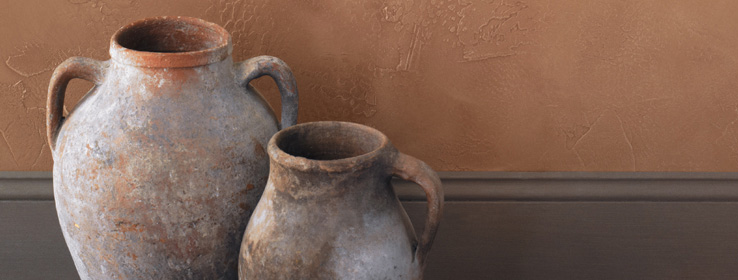What's behind the growing influence of Africa on international design.
African design is growing in popularity, especially in the home d+¬cor industry, where demand is outstripping supply. The call is not for the masks and statues sold on sidewalks around the world; rather, interior decorators are looking to African designers for naturally sourced, handcrafted objects and fabrics with a rich sense of color, culture and history. And an added benefit is that many Africa-based design initiatives provide much-needed sources of income to impoverished local communities.
Beautiful baskets
African woven baskets are storied design items that have both a practical purpose and interesting background. "The hand of the maker can be seen in the intricately woven patterns," says AJ DeForest, co-owner of Pfeifer Studio. "Our oversized vintage African wedding baskets are everyday styles from Zambia, which were used to collect grain, seeds and vegetables from the fields. They were often filled with cassava roots and set out to dry in the sun. Since each basket took a month or longer to weave, women opted to repair them rather than weaving new ones. Patches made from banana leaf or corn husk are woven into place using the same makenge roots with which the basket was originally created."
African wedding baskets can be used in a variety of ways. "Although baskets always look great when placed on a table, we also love them hung on a wall," says DeForest. "They are appealing when shown in groups, highlighting the unique nature of each one, and can also be hung with other types of objects, such as paintings and textiles, to create pleasing, organic compositions."
Incredible textiles
To bring a more "tribal" feel to a room, choose fabrics and textiles that tell a story. Kente cloth is created by weaving together silk fabric strips. Kente, native to Ghana, is a pan-African symbol and serves as the tribal cloth for many ethnic groups in Togo, the Ivory Coast and Ghana. The fabric is held in high esteem and worn only for special occasions. It is the most recognizable of African textiles.
The colors used in kente cloth carry symbolic meaning. Peacefulness, growth, healing or royalty are just some of the qualities suggested through the colors of a fabric. Patterns are also of importance, whether obvious or intricate.
Kuba cloths, another ornate textile from Africa, are a traditional, geometric-patterned African cloth woven using primitive techniques that have been employed for centuries, according to DeForest. "The cloths get their name from the Kuba tribe of central Congo. The tribe's women begin the process of creating the cloths by beating palm leaves so that the leaf will separate into fibers. The men then use a loom to weave the fibers. The process then goes back to the women, who decorate the cloth. Sometimes they use a 'u' stitch to create a carpet-like texture as well as motifs. Other times they use appliqu+¬ methods to create patterns and motifs. Each cloth can take over a month to make," he says.
"In the past the cloth was only made by the most important and wealthy men in the tribe. Their wives were the only women in the tribe who had enough spare time to embroider the cloth. Ordinary women were kept too busy with their work in the fields, cooking and raising their children," says DeForest. "Thus the cloth became a symbol of wealth and status."
Both kente and kuba cloth offer a rich story and history and can be used as tapestry, rug, drape, pillow or even upholstery fabric.
Choosing a color palette
Many African-inspired d+¬cor items are brilliantly colored, bold statement pieces. There are several schools of thought about how to highlight them. "Contrast neutrals, deep browns and black with unbleached whites and ochres, tans and browns," says Vicki Lederman, home furnishings design and product development professional. Another way to draw the eye to incredible pieces is to offset them with rich colors. Opulent blue or dusty gray can both accent the intricate details of tribal pieces while lending a calming influence on the room. By contrast, a deep, spicy red can breathe new life into these exotic items, making them fairly dance on walls and surfaces.
Sherwin-Williams Rooted palette:
SW 6107 Nomadic Desert
SW 2817 Rookwood Amber
SW 7514 Foothills
SW 6607 Red Tomato
SW 6496 Oceanside
For more information:
- www.sherwin-williams.com/pro/paint_colors/paint_color_trends/2010/rooted/index.jsp
African Accents: Fabrics and Crafts to Decorate Your Home by Lisa Shepherd. (Krause Publications, 1999)
African Style: Down to the Details by Sharne Algotsson. (Clarkson Potter, 2000)
Image provided by and used with the permission of AJ DeForest/Pfeifer Studio.








